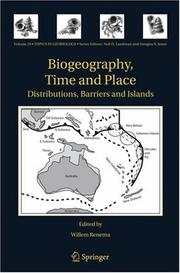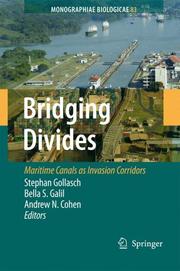| Listing 1 - 10 of 14 | << page >> |
Sort by
|
Book
ISBN: 0632068701 9780632068708 Year: 1971 Publisher: Oxford Blackwell Scientific publ
Abstract | Keywords | Export | Availability | Bookmark
 Loading...
Loading...Choose an application
- Reference Manager
- EndNote
- RefWorks (Direct export to RefWorks)
Zoogeography --- Birds --- Isolating mechanisms --- Bird populations --- Bird populations. --- Isolating mechanisms. --- Isolation, Biotic --- Isolation mechanisms --- Reproductive isolation mechanisms --- Evolution (Biology) --- Reproduction --- Species --- Vertebrate populations

ISBN: 9780309526574 0309526574 9780309526579 9780309089913 0309089913 0309166705 Year: 2004 Publisher: Washington, D.C. : National Academies Press,
Abstract | Keywords | Export | Availability | Bookmark
 Loading...
Loading...Choose an application
- Reference Manager
- EndNote
- RefWorks (Direct export to RefWorks)
Evolution (Biology) --- Species --- Isolating mechanisms --- Science --- Study and teaching. --- Science education --- Scientific education --- Isolation, Biotic --- Isolation mechanisms --- Reproductive isolation mechanisms --- Speciation (Biology) --- Animal evolution --- Animals --- Biological evolution --- Darwinism --- Evolutionary biology --- Evolutionary science --- Origin of species --- Evolution --- Reproduction --- Biology --- Genetics --- Hybridization --- Organisms --- Biological fitness --- Homoplasy --- Natural selection --- Phylogeny
Book
ISBN: 0231048769 Year: 1982 Publisher: New York Columbia University Press
Abstract | Keywords | Export | Availability | Bookmark
 Loading...
Loading...Choose an application
- Reference Manager
- EndNote
- RefWorks (Direct export to RefWorks)
AMS South America --- Central America --- South America --- biodiversity --- biogeography --- symposium proceedings --- variation --- ZV Biogeography --- Biogeography --- Isolating mechanisms --- Species --- Variation (Biology) --- Biological variation --- Biology --- Heredity --- Genetics --- Mutation (Biology) --- Speciation (Biology) --- Hybridization --- Organisms --- Isolation, Biotic --- Isolation mechanisms --- Reproductive isolation mechanisms --- Evolution (Biology) --- Reproduction --- Areography (Biology) --- Geographical distribution of animals and plants --- Species distribution --- Geography --- Congresses --- Geographical distribution

ISBN: 1281067369 9786611067366 1402063741 1402063733 Year: 2007 Publisher: Dordrecht : Springer,
Abstract | Keywords | Export | Availability | Bookmark
 Loading...
Loading...Choose an application
- Reference Manager
- EndNote
- RefWorks (Direct export to RefWorks)
Biogeography considers the distribution of biological units over a wide range of scales. The units range from genotypes, populations and species to families and higher taxa. Processes can be local, such as the isolation on islands due to sea-level fluctuations, or large-scale tectonic processes that separates continents and creates oceans. In all processes time is an important factor and by combining data on recent patterns with paleontological data the understanding of the distribution of extant taxa can be improved. This volume focuses on speciation due to isolation in island-like settings, and the evolution of large-scale diversity as the result of origination, maintenance and extinction.
Zoogeography. --- Paleobiogeography. --- Isolating mechanisms. --- Animal species. --- Island animals --- Animals --- Biodiversity. --- Evolution. --- Geographical distribution. --- Dispersal. --- Biological diversification --- Biological diversity --- Biotic diversity --- Diversification, Biological --- Diversity, Biological --- Biology --- Biocomplexity --- Ecological heterogeneity --- Numbers of species --- Animal dispersal --- Dispersal of animals --- Insular animals --- Island fauna --- Species --- Isolation, Biotic --- Isolation mechanisms --- Reproductive isolation mechanisms --- Evolution (Biology) --- Reproduction --- Geographical distribution of fossil animals and plants --- Biogeography --- Paleontology --- Animal distribution --- Animal geography --- Distribution of animals, Geographical --- Geographical distribution of animals --- Zoology --- Classification --- Geographical distribution
Book
ISBN: 128059456X 9786613624390 0191628018 9780191628016 9780199587100 0199587108 9780199587117 0199587116 0191628026 Year: 2012 Publisher: Oxford : Oxford University Press,
Abstract | Keywords | Export | Availability | Bookmark
 Loading...
Loading...Choose an application
- Reference Manager
- EndNote
- RefWorks (Direct export to RefWorks)
The origin of biological diversity, via the formation of new species, can be inextricably linked to adaptation to the ecological environment. Specifically, ecological processes are central to the formation of new species when barriers to gene flow (reproductive isolation) evolve between populations as a result of ecologically-based divergent natural selection. This process of 'ecological speciation' has seen a large body of particularly focused research in the last 10-15 years, anda review and synthesis of the theoretical and empirical literature is now timely.The book begins by clarifying wha
Evolution. --- Species. --- Symbiogenesis. --- Biodiversity --- Evolution (Biology) --- Isolating mechanisms --- Niche (Ecology) --- Species --- Speciation (Biology) --- Biology --- Genetics --- Hybridization --- Organisms --- Microhabitat --- Biotic communities --- Competition (Biology) --- Ecology --- Habitat (Ecology) --- Isolation, Biotic --- Isolation mechanisms --- Reproductive isolation mechanisms --- Reproduction --- Animal evolution --- Animals --- Biological evolution --- Darwinism --- Evolutionary biology --- Evolutionary science --- Origin of species --- Evolution --- Biological fitness --- Homoplasy --- Natural selection --- Phylogeny --- Biological diversification --- Biological diversity --- Biotic diversity --- Diversification, Biological --- Diversity, Biological --- Biocomplexity --- Ecological heterogeneity --- Numbers of species --- Isolating mechanisms. --- Biodiversity.
Book
ISBN: 1400888212 Year: 2017 Publisher: Princeton, NJ : Princeton University Press,
Abstract | Keywords | Export | Availability | Bookmark
 Loading...
Loading...Choose an application
- Reference Manager
- EndNote
- RefWorks (Direct export to RefWorks)
Evolutionary Community Ecology develops a unified framework for understanding the structure of ecological communities and the dynamics of natural selection that shape the evolution of the species inhabiting them. All species engage in interactions with many other species, and these interactions regulate their abundance, define their trajectories of natural selection, and shape their movement decisions. Mark McPeek synthesizes the ecological and evolutionary dynamics generated by species interactions that structure local biological communities and regional metacommunities.McPeek explores the ecological performance characteristics needed for invasibility and coexistence of species in complex networks of species interactions. This species interaction framework is then extended to examine the ecological dynamics of natural selection that drive coevolution of interacting species in these complex interaction networks. The models of natural selection resulting from species interactions are used to evaluate the ecological conditions that foster diversification at multiple trophic levels. Analyses show that diversification depends on the ecological context in which species interactions occur and the types of traits that define the mechanisms of those species interactions. Lastly, looking at the mechanisms of speciation that affect species richness and diversity at various spatial scales and the consequences of past climate change over the Quaternary period, McPeek considers how metacommunity structure is shaped at regional and biogeographic scales.Integrating evolutionary theory into the study of community ecology, Evolutionary Community Ecology provides a new framework for predicting how communities are organized and how they may change over time.
Species. --- Ecology. --- Natural selection. --- adaptation. --- biodiversity. --- biogeographic mixing. --- climate change. --- coevolution. --- coexistence. --- community ecology. --- community mixing. --- community module. --- community structure. --- community. --- dispersal. --- ecological community. --- ecological differentiation. --- ecological opportunity. --- evolution. --- extinction. --- fitness. --- habitat alteration. --- interaction network. --- intraguild predation. --- invasibility. --- invasion. --- invasive species. --- metacommunity. --- mutualism. --- natural selection. --- neutral species. --- new species. --- omnivory. --- phenotypic plasticity. --- phylogeny. --- predation. --- predator. --- prey. --- reproductive isolation. --- resource competition. --- speciation. --- species interaction. --- species. --- trait. --- trophic interaction.

ISBN: 1280716533 9786610716531 140205047X 1402050461 9048172659 Year: 2006 Publisher: Dordrecht : Springer Netherlands : Imprint: Springer,
Abstract | Keywords | Export | Availability | Bookmark
 Loading...
Loading...Choose an application
- Reference Manager
- EndNote
- RefWorks (Direct export to RefWorks)
Maritime canals dissolve natural barriers to the dispersal of marine organisms, thus providing novel opportunities for natural dispersal, as well as for shipping-mediated transport. The introduction of alien species has proved to be one of the most profound and damaging of anthropogenic deeds - with both ecological and economic costs. This book is the first to assess the impacts of the world’s three principal maritime canals – the Kiel, the Panama, the Suez – as invasion corridors for alien biota. These three canals differ in their hydrological regimes, the types of biotas they connect, and in their permeability to invasions. Dr. Stephan Gollasch was involved in the first European ship sampling programme on ballast water, tank sediments and ship hull fouling (1992-1996). His PhD is world-wide the first thesis based on ballast water sampling. In addition to laboratory and desk studies he spent more than 125 days at sea during several biological surveys and joint ships on their voyages through the Kiel and Suez Canals. Due to the international aspect of biological invasions Dr. Gollasch became a member of several international working groups: International Council for the Exploration of the Sea (ICES); International Maritime Organization (IMO), and the Baltic Marine Biologists (BMB). As an independent consultant he is today involved projects related to biological invasions (e.g. ballast water treatment, ship sampling, risk assessment). Recently he was involved in the development of risk assessments and ballast water management scenarios for the European Atlantic coast, North, Baltic, Caspian and Mediterranean Seas. Dr. Bella Galil is a Senior Research Scientist at the National Institute of Oceanography, Israel. Her main research interests are the anthropogenic changes occurring in the Levantine marine biota, and the impact of alien species on the Mediterranean ecosystem. She has conducted numerous studies and surveys off the Israeli coast monitoring the benthic biota from the intertidal to the bathyal. She co-chairs the scientific committee of marine ecosystems of the International Commission for Scientific Exploration of the Mediterranean (CIESM), and is a member of the Invasive Species Scientific Committee, IUCN. Galil published over 130 papers in scientific journals and co-edited a volume of the "CIESM Atlas of Exotic species in the Mediterranean". Recently she coordinated the drafting of Guidelines for controlling the vectors of introduction into the Mediterranean of non-indigenous species and invasive marine species for the UNEP Mediterranean Action Plan Regional Activity Centre for Specially Protected Areas RAC/SPA. Dr. Andrew Cohen is the Director of the Biological Invasions Program at the San Francisco Estuary Institute in Oakland, California. His research has focused on the extent, impacts and vectors of aquatic invasions. He has organized and led rapid assessment surveys for exotic marine species in various localities including one at both ends of the Panama Canal. He helped write California's first ballast water law in 1999, and recently helped develop ballast water discharge standards for the state that seem likely to be enacted this year. He also drafted a petition from the research community that led to a U.S. ban on importing the "Killer Seaweed" Caulerpa taxifolia, and provided technical assistance to a recently successful lawsuit that will force ballast water discharges into U.S. waters to be regulated as biological pollutants under the U.S. Clean Water Act. For his work he has received a Pew Marine Conservation Fellowship and the San Francisco BayKeeper's Environmental Achievement Award. .
Isolating mechanisms. --- Biological invasions. --- Canals --- Environmental aspects. --- Channels (Hydraulic engineering) --- Hydraulic structures --- Inland navigation --- Bio-invasions --- Bioinvasions --- Invasions, Biological --- Natural selection --- Population biology --- Isolation, Biotic --- Isolation mechanisms --- Reproductive isolation mechanisms --- Evolution (Biology) --- Reproduction --- Species --- Aquatic biology. --- Ecology. --- Nature Conservation. --- Freshwater & Marine Ecology. --- Geoecology/Natural Processes. --- Hydrobiology --- Water biology --- Aquatic sciences --- Biology --- Balance of nature --- Bionomics --- Ecological processes --- Ecological science --- Ecological sciences --- Environment --- Environmental biology --- Oecology --- Environmental sciences --- Conservation of nature --- Nature --- Nature protection --- Protection of nature --- Conservation of natural resources --- Applied ecology --- Conservation biology --- Endangered ecosystems --- Natural areas --- Ecology --- Conservation --- Aquatic ecology . --- Geoecology. --- Environmental geology. --- Nature conservation. --- Ecology . --- Geoecology --- Environmental protection --- Physical geology --- Aquatic biology

ISBN: 0691117586 069111983X Year: 2004 Publisher: Princeton Princeton university press
Abstract | Keywords | Export | Availability | Bookmark
 Loading...
Loading...Choose an application
- Reference Manager
- EndNote
- RefWorks (Direct export to RefWorks)
575.8 --- 57.022 --- 575.1 --- Evolution. Origin of species. Phylogeny --- Interaction of the organism with its (normal) environment. Viability. --- Heredity. Inheritance --- GEN Genetics & Population Genetics --- selection --- speciation --- reproductive isolation --- theory --- genetic incompatibility --- 575.1 Heredity. Inheritance --- 57.022 Interaction of the organism with its (normal) environment. Viability. --- 575.8 Evolution. Origin of species. Phylogeny --- Evolution (Biology) --- Population biology --- Population genetics --- Species diversity --- Species --- Speciation (Biology) --- Biology --- Genetics --- Hybridization --- Organisms --- Diversity, Species --- Richness, Species --- Species richness --- Biodiversity --- Ecology --- Mathematical models --- Interaction of the organism with its (normal) environment. Viability
Book
ISBN: 1283152487 9786613152480 1400838932 9781400838936 9781283152488 9780691128931 0691128936 9780691128948 0691128944 Year: 2011 Publisher: Princeton, N.J. Princeton University Press
Abstract | Keywords | Export | Availability | Bookmark
 Loading...
Loading...Choose an application
- Reference Manager
- EndNote
- RefWorks (Direct export to RefWorks)
"Understanding the mechanisms driving biological diversity remains a central problem in ecology and evolutionary biology. Traditional explanations assume that differences in selection pressures lead to different adaptations in geographically separated locations. This book takes a different approach and explores adaptive diversification--diversification rooted in ecological interactions and frequency-dependent selection. In any ecosystem, birth and death rates of individuals are affected by interactions with other individuals. What is an advantageous phenotype therefore depends on the phenotype of other individuals, and it may often be best to be ecologically different from the majority phenotype. Such rare-type advantage is a hallmark of frequency-dependent selection and opens the scope for processes of diversification that require ecological contact rather than geographical isolation. Michael Doebeli investigates adaptive diversification using the mathematical framework of adaptive dynamics. Evolutionary branching is a paradigmatic feature of adaptive dynamics that serves as a basic metaphor for adaptive diversification, and Doebeli explores the scope of evolutionary branching in many different ecological scenarios, including models of coevolution, cooperation, and cultural evolution. He also uses alternative modeling approaches. Stochastic, individual-based models are particularly useful for studying adaptive speciation in sexual populations, and partial differential equation models confirm the pervasiveness of adaptive diversification. Showing that frequency-dependent interactions are an important driver of biological diversity, Adaptive Diversification provides a comprehensive theoretical treatment of adaptive diversification"-- "Adaptive biological diversification occurs when frequency-dependent selection generates advantages for rare phenotypes and induces a split of an ancestral lineage into multiple descendant lineages. Using adaptive dynamics theory, individual-based simulations, and partial differential equation models, this book illustrates that adaptive diversification due to frequency-dependent ecological interaction is a theoretically ubiquitous phenomenon"--
Evolution (Biology) --- Biodiversity --- Adaptation (Biology) --- Biological diversification --- Biological diversity --- Biotic diversity --- Diversification, Biological --- Diversity, Biological --- Biology --- Biocomplexity --- Ecological heterogeneity --- Numbers of species --- Environment --- Self-organizing systems --- Variation (Biology) --- Biological fitness --- Genetics --- Mathematical models. --- LotkaЖolterra models. --- Maynard Smith model. --- Richard Lenski. --- adaptive diversification. --- adaptive dynamics theory. --- adaptive dynamics. --- adaptive speciation. --- anisogamy. --- asexual speciation. --- assortative mating. --- biological diversity. --- clonal models. --- coevolution. --- coevolutionary dynamics. --- conformist cultures. --- cooperative interactions. --- crossfeeding. --- cultural evolution. --- dispersal rates. --- disruptive selection. --- diverging phenotypic clusters. --- diversification. --- ecological character displacement. --- ecological dynamics. --- ecology. --- ecosystem. --- evolutionary biology. --- evolutionary branching. --- evolutionary dynamics. --- evolutionary processes. --- evolutionary trajectory. --- experimental evolution. --- frequency dependence. --- frequency independence. --- frequency-dependent competition. --- frequency-dependent interactions. --- frequency-dependent selection. --- gamete size. --- individual-based models. --- intraspecific cooperation. --- language memes. --- language. --- mainstream culture. --- mathematical modeling. --- mating populations. --- microbes. --- mutualism. --- mutualistic interactions. --- niche ecology. --- partial differential equation models. --- pattern formation. --- phenotype distributions. --- phenotype. --- phenotypic differentiation. --- phenotypic divergence. --- polymorphic populations. --- polymorphism. --- polymorphisms. --- predation. --- predatorаrey interactions. --- prezygotic reproductive isolation. --- religion. --- religious diversification. --- reproductive isolation. --- resource competition. --- sexual populations. --- sexual reproduction. --- speciation model. --- trophic preference. --- Environmental adaptation --- Adaptation, Environmental
Book
ISBN: 3039281275 3039281267 Year: 2020 Publisher: MDPI - Multidisciplinary Digital Publishing Institute
Abstract | Keywords | Export | Availability | Bookmark
 Loading...
Loading...Choose an application
- Reference Manager
- EndNote
- RefWorks (Direct export to RefWorks)
The way plants grow and develop organs significantly impacts the overall performance and yield of crop plants. The basic knowledge now available in plant development has the potential to help breeders in generating plants with defined architectural features to improve productivity. Plant translational research effort has steadily increased over the last decade due to the huge increase in the availability of crop genomic resources and Arabidopsis-based sequence annotation systems. However, a consistent gap between fundamental and applied science has yet to be filled. One critical point often brought up is the unreadiness of developmental biologists on one side to foresee agricultural applications for their discoveries, and of the breeders to exploit gene function studies to apply to candidate gene approaches when advantageous on the other. In this book, both developmental biologists and breeders make a special effort to reconcile research on the basic principles of plant development and organogenesis with its applications to crop production and genetic improvement. Fundamental and applied science contributions intertwine and chase each other, giving the reader different but complementary perspectives from only apparently distant corners of the same world.
HD-Zip transcription factors --- Plant in vitro cultures --- plant breeding --- recalcitrant species --- CLV --- wounding --- semi-dwarf --- photoreceptors --- Arabidopsis thaliana --- root development --- morphogenesis --- embryogenesis --- cytokinin --- auxin conjugation --- molecular marker --- Development --- boundaries --- translational research --- proline biosynthesis --- Brassicaceae --- meristem formation --- phytohormones --- stem cells --- meristem --- cytoskeleton --- hydrogen peroxide --- ligule --- genetic improvement --- tree phase change --- Rht18 --- hairy roots --- WUS --- GRETCHEN HAGEN 3 (GH3) IAA-amido synthase group II --- photoperiod --- linkage map --- SAM --- ground tissue --- signaling --- differentiation --- protoxylem --- ambient temperature --- gibberellins --- molecular regulation --- proximodistal patterning --- wheat-rye hybrids --- RolD --- somatic cell selection --- flowering time --- plant development and organogenesis --- grass --- root --- wheat --- crop productivity --- genetic transformation --- regulatory networks --- light environment --- rol genes --- root plasticity --- morphogenic --- stem apical meristem --- auxin --- shoot meristem --- Arabidopsis --- organogenesis --- transformation --- Vasculature --- Organogenesis --- radial patterning --- plant development --- reduced height --- root apical meristem --- Asteraceae --- vernalization --- KNOX transcription factors --- locule --- plant cell and tissue culture --- Agrobacterium rhizogenes --- genes of reproductive isolation --- cell wall --- lateral root cap --- CLE --- auxin minimum --- age
| Listing 1 - 10 of 14 | << page >> |
Sort by
|

 Search
Search Feedback
Feedback About
About Help
Help News
News